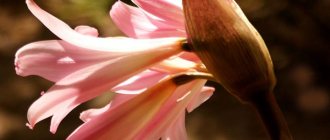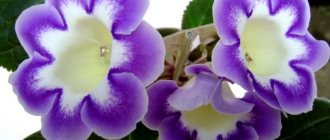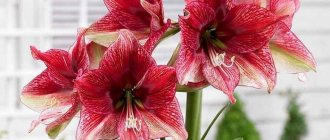Author: Elena N. https://floristics.info/ru/index.php?option=com_contact&view=contact&id=19 Category: Houseplants Published: February 21, 2019Last edits: January 11, 2021
Most of the beautifully flowering plants, after their flowering is complete, go into a dormant state. Plants need rest to restore the energy spent on flower formation and to lay flower buds for the next flowering. Bulbous crops such as amaryllis (hippeastrum) are no exception in this regard. There is a certain procedure for introducing bulbous plants during the dormant period. From our article you will learn:
- how to prepare amaryllis for the dormant period;
- how to cover bulbs overwintering in the ground;
- when to remove bulbs from the ground for the winter;
- how to store bulbs until new planting.
Preparing amaryllis for the dormant period
The dormant period for amaryllis is the end of autumn and the beginning of winter. For hippeastrums, the dormant period begins after the plant has flowered, because hippeastrums can be driven out at any time of the year, and not just at the end of summer or early autumn. Early forcing in autumn or late is possible - then the hippeastrum blooms at the end of winter or beginning of spring. Some varieties bloom even in summer.
But whenever your amaryllis or hippeastrum blooms, it needs a period of rest. So far, only one evergreen species of hippeastrum is known - Hippeastrum Papilio, for which there is no need for a dormant period. The remaining varieties of amaryllis and hippeastrum should rest. If you planted amaryllis or hippeastrum in the ground for the summer, then you need to dig its bulb out of the ground before frost and store it in a cool, dark, dry place.
- Abutilon - care, photos, types
Varieties
Modern hybrids can be divided into three broad groups:
- Large-flowered varieties . These are Double Roma, Exotica, White Baby, Ampulo. The diameter of flowers of these species can reach 20–25 cm.
- Varieties with unusual colors . Striped, speckled, with a border or throat of a contrasting color - there are a lot of variations in the color of amaryllis. This group includes Charisma, Clown, Pizazz, Prelude.
- Spiders, or narrow-petalled varieties . Their flowers are not very large, but benefit from the unusual shape of the cups. These are varieties such as La Paz, Spotty, Evergreen.
Photo gallery: hybrid varieties of amaryllis
Amaryllis Desire
Amaryllis Grandeur
Amaryllis Blak Pearl (Black Pearl)
Amaryllis La Paz
Amaryllis Nimph (Nymph)
Amaryllis Exotika (Exotic)
Amaryllis Minerva (Minerva)
Amaryllis Exotik star (Exotic star)
Amaryllis White Baby
Leaves are a source of nutrients
However, the amaryllis bulb is not immediately dug up after flowering; you must first allow the leaves to do the important job of supplying the bulb with nutrients.
In the period preceding dormancy, it is necessary to prepare the bulb and give it the opportunity to recover after flowering. The leaves should dry naturally, giving all their strength to the bulb. From mid-September, the frequency of watering amaryllis (or hippeastrum) is reduced. Once the leaves have completely yellowed and died, the plant will go dormant on its own.
Description
Monocot, belongs to the genus Amaryllidaceae. Lives in the tropics of South Africa. The bulb is large, elongated, 10 cm in diameter. Brown, covered with gray husk on the outside. The sprouts emerge from the center. Dense tall stem. Before flowering, it shoots an arrow with an inflorescence at the end. The buds are collected in an umbrella of 5-6 pieces.
The flowers are similar to a lily, average size 8-10 cm in length, with 6 petals. The predominant shades are white, scarlet, lilac, and orange. They emit a pleasant aroma. The leaves are long, narrow, belt-shaped, growing from the roots.
Two varieties have been found in nature:
Belladonna
The most ancient and popular. Homeland Cape Province. Stem length 50 cm. Vegetation in February and August. The flowers are big. Snowy or passionate shade. There are 10-12 on one inflorescence. The smell is subtle and delicate.
Paradisicola
Discovered in 1998. Grows on southern slopes in rocky areas. Not intended for home growing. There are 21 on the inflorescence. Pink, it becomes richer during the blooming process.
Wintering amaryllis and hippeastrum
The main dormant period for amaryllis is 2-3 autumn months. If the plant was planted in open ground for the summer, then after flowering the amaryllis must be dug up and replanted in a pot before frost.
Hippeastrum can be left in the ground for the winter. In general, it is enough to replant these flowers once every 3-4 years. And in order for the hippeastrum in the garden to easily withstand frost, it must be covered with a dense layer of peat or other mulch.
But if you decide to take the hippeastrum indoors for the winter, the main thing is to provide its bulb with a cool temperature within 10-18°C.
Reproduction methods
Amaryllis is easy to propagate. Use 2 methods.
Seeds
Flowering with this method of propagation can be expected only after 5 years. During flowering, use a brush to pollinate the plant (transfer pollen from the stamen to the pistil of another inflorescence). The ripeness of the seed pods is indicated by their opening.
Seeds remain viable for 1.5 months. Sow them to a depth of 0.5 cm in a moist substrate. Keep it at a temperature of +22-25 degrees. When several leaves appear, the plant is planted in individual pots. During the first years of propagation from seeds, amaryllis should remain with leaves. It should be borne in mind that when propagating from seeds, there is no 100% guarantee that all varietal characteristics of amaryllis will be preserved.
By cuttings or dividing the bulb
A more reliable and faster method of reproduction. Babies are formed in healthy bulbs. Sometimes they release leaves right away. It is better to separate them and, without waiting for the flower to be transplanted, transplant them into separate pots. As the amaryllis grows, the container for the children needs to be increased.
Temperature
When at rest, amaryllis and hippeastrum bulbs should be kept in a cool room. It is best if the temperature is about 15°C, but a temperature of 10°C is also considered acceptable, and the upper value is 18°C. If it is cooler, the bulb may hurt, and if it drops below 5°C, it may die.
- Jacaranda - care, photos, types
Therefore, if you live in an area where the soil freezes below 5°C in winter, it is better to dig up the bulbs for the winter. This is especially true for amaryllis. A higher temperature than 18ºC during the dormant period may cause the bulb to germinate too quickly.
This is also not very good, since the plant did not have time to rest, and it is complete rest that guarantees the establishment of a healthy flower arrow.
During dormancy, you only need to water the bulb so that it does not dry out - once every month and a half. Moreover, water must be poured into the pan so that in conditions of cool air and excess water the bulb does not rot.
You will know that the recuperation period is over when a flower shoot appears on the amaryllis bulb. But active watering and fertilizing should begin only after this arrow extends to 10 cm. From this moment a new growth cycle of amaryllis or hippeastrum begins. Now you need to learn how to care for amaryllis at home and in the garden, depending on where it will grow.
Where to store the bulb in winter?
The bulbs should overwinter in a dark, cool place, but this is not easy to find in apartment conditions. The balcony is not very suitable for wintering, especially an open one, because there the bulb will freeze and die.
The best option is storage on the bottom shelf in the refrigerator. Every two weeks it is necessary to check the condition of the bulbs. If there is no free space there, then you can simply leave the bulb in the flowerpot.
Before placing the onion in the refrigerator, wrap it in a napkin or toilet paper.
In mid-February, amaryllis should be taken out of the refrigerator and forced to grow.
Features of wintering amaryllis - video
Given the fairly cool climate of our region, one of the most favorite indoor plants is amaryllis, which blooms in winter.
Modern varieties of this native from the warm countries of Africa can be of completely different color shades - from pure white to purple, dark crimson and, no matter how strange it may seem, green. There are also representatives of this species with striped or double flowers.
This bulbous plant is considered one of the most convenient for forcing at home, which even an inexperienced amateur gardener can do.
The soil
For amaryllis, a soil consisting of turf soil (2 parts), peat (1 part), humus (1 part) and sand (1 part) is suitable. The soil acidity indicator should be pH 6.0–6.5.
You can also use a different soil composition for planting this plant. Here are its ingredients:
- Sod land - 2 parts;
- Leaf soil - 2 parts;
- Humus – 1 part;
- Peat – 1 part;
- Washed river sand – 1 part.
Sand can be replaced with leavening agents such as perlite or vermiculite. The specified soil composition will ensure the outflow of excess water into the pan during watering.
Also, to prevent water from stagnating in the soil, a drainage layer is placed at the bottom of the pot. Good drainage is essential to prevent root and bulb rot.
Light and loose soil, slightly acidic or neutral acidity, is suitable for amaryllis. Such soil mixtures for decorative flowering bulbous plants are always on sale. They are easiest to purchase at flower shops or garden centers.
Fertilizer
During active growth and flowering, fertilizing is carried out once every 10 days. To do this, use a complex liquid fertilizer suitable for flowering plants.
At the end of flowering, fertilizing is reduced, and after the leaves wither, stop completely . Fertilizer application is resumed only with the appearance of flower stalks from the bulb.
They begin to fertilize the soil for amaryllis when flower stalks appear from the bulb in the spring. Use liquid complex fertilizers for flowering plants or special formulations for bulbous plants.
It is important not to overfeed the plants after the leaves form and flowering ends. This species grows leaves after the formation of a peduncle. The plant is fed only with fertilizers for flowering plants, never using formulations for deciduous varieties. This allows you to maximize flowering and reduce the rate of leaf growth.
Diseases
Amaryllis can be affected by fungal infections, such as gray mold. Signs of infection: brown spots or stripes on flowers, stems or bulbs, or a grayish velvety coating on the leaves.
As a rule, the disease is caused by too humid air and waterlogging of the soil.
The causative agents of this disease live in the soil, so the diseased plant must be replanted. In addition, they are treated with special preparations - fungicides.
The plant can become infected with thrips or aphids . Signs: leaves turn yellow and become deformed.
Small reddish spots may appear when infested with mites. Treatment with insecticides, which must be carried out several times, will help in pest control.











